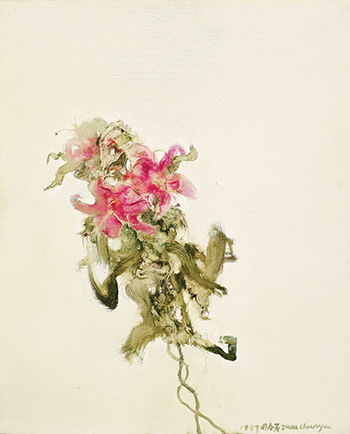Catalogue Note:
Zhou Chunya returned to China in 1989, having been influenced by Expressionism while in Germany. He devoted the following years to the learning of literati arts of traditional Chinese, and was particularly inspired by the masters Dong Qichang, Shitao, Bada Shanren, and Huang Binhong. What he found were brand new possibilities between the German Expressionism and the “sentiments of brush and ink” of Chinese literati works. In 1997, he created many flower-themed pieces, paving a new road with the historical heritage of literati paintings. In this series the flowers are often suspended alone on the empty canvas, representing a call back to the concept of “negative space” from Chinese ink wash painting, which also restricts the possibility of further alternation. “Flowers” is one of the fascinating works among the series.
The brushwork in “Flowers” is bold and bright, showing no signs of hesitation. Green and red on the canvas seem to both clash and coalesce at the same time. In the midst of such rich color, blooming red lilies with elegant leaves and stems shine through, displaying Zhou’s superb ability to form his subjects. Yet realistic depictions are not what the artist is truly concerned with. “Flowers” clearly conveys what Zhou had learned from Chinese literati traditions: the ethos of “imbuing a scene with feeling.” While Zhou inherited this ethos, his art takes a direction which is opposite to the modesty and grace of the elder generation; he gazes directly into the wishes and desires of humanity. The rich layering of color and the texture of its surface, as well as the high contrast of density in the spacing, enliven the once passive flower into a burgeoning vitality. The painting maintains the flower’s gentle charms, while allowing sudden glimpses of raging tension, mixing gentleness and nobility with passion and impetuosity.
The brushwork in “Flowers” is bold and bright, showing no signs of hesitation. Green and red on the canvas seem to both clash and coalesce at the same time. In the midst of such rich color, blooming red lilies with elegant leaves and stems shine through, displaying Zhou’s superb ability to form his subjects. Yet realistic depictions are not what the artist is truly concerned with. “Flowers” clearly conveys what Zhou had learned from Chinese literati traditions: the ethos of “imbuing a scene with feeling.” While Zhou inherited this ethos, his art takes a direction which is opposite to the modesty and grace of the elder generation; he gazes directly into the wishes and desires of humanity. The rich layering of color and the texture of its surface, as well as the high contrast of density in the spacing, enliven the once passive flower into a burgeoning vitality. The painting maintains the flower’s gentle charms, while allowing sudden glimpses of raging tension, mixing gentleness and nobility with passion and impetuosity.
